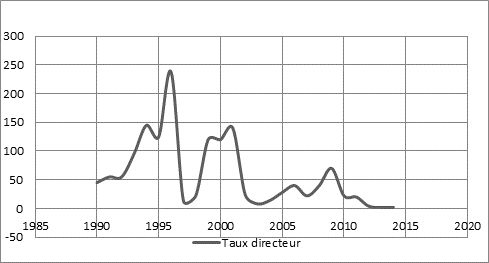Yield structures in the Congolese financial system
- Gaëtan Munkeni
- Apr 28, 2021
- 4 min read
Updated: May 1, 2021
The real effect of the various changes in the Central Bank of Congo's key rate has always been one of the most debatable reality in the Congolese financial landscape. The shortcomings of this chain of command stem from the theoretical approach of the yield curve or lack of in the present context.
· What is a yield curve
A Yield curve is generally defined as a graphical representation of interest rate applicable to a particular fix income security and the various terms at which they are applicable.
Changes in the yield curve come about by the influence of market participants. Because the curve essentially concerns fixed income (mainly debt) instruments, the demand from buyers (mainly institutional investors such as banks, funds and the likes) and the supply from sellers such as Governments and Corporations and other financial institutions, fix the different levels of rate according to terms.
Another key actor in this equations is the central bank. By their monetary policy instruments and decisions, central banks are able to impact the demand and supply of money and credit, which, in turn, impacts the set of actors described earlier.
· Why is a yield curve important for an economy
What a yield curve assists with is essentially allowing financial market participants to have a long term view on the potential return on fix income (specifically) and/or general investments. This is important because of it allows financial planning in the medium to long-term which is one of the main shortfall of low income economies.
Another key usage of yield curves is its ability to act as an economic indicator via the possibility to forecast upcoming economic events such as inflation or recessions.
· How it works
Without going into full details of the various curve theories, a positive yield curve whereby short term rates are lower and long term ones, is a usual indicator a positive long-run sentiment in the economy expected to result in increased spending. In that way, the yield curve is an interesting forecaster of future inflation.
On the other hand, a negatively sloped curve projects a potential economic downturn of some kind, possibly leading to recessions depending on the steepness of the slope.
Similar to the long-term investment capability of the economy, long-term forecasting and economic sentiment analysis is an aspect low income economies are struggling with.
· The local scenario
Albeit essentially short-term, the Central Bank of Congo issues a series of yields for Congolese Francs fix income denominated securities. With a generally dollarized economy, the set rates present on such a curve, will only be able to impact local currency instruments exchanged in a very limited market essentially comprised of institutional investors, which, in the DRC market, basically means commercial banks.
In addition to its limited size, the popularity of local currency denominated securities suffers from impacts of inflation and subsequent currency depreciation which limits appetite for medium and long term investments as they hurt effective return.
· How will the local economy differ with a proper functioning yield curve?
As previously explained, the local economy stands to gain from a properly set up and useful yield curve. However, only a local currency run economy would allow for those benefits to settle in. In view of the challenges the authorities have had in their de-dollarization attempts over the years, a logical reasoning would attempt running the local financial system based on a foreign dollar denominated fix income yield curve.
Whilst a number of scholar and international financial institutions such as the European Central Bank have recognised the impact of foreign set yield curves on a certain number of local economies, the issue is that those links remains remote and limited.
A key hurdle sits with the configuration and cost structure of the local financial system, essentially made of commercial Banks, whose balance sheet mainly comprises call deposits and a limited amount of term deposits (the only regulated US Dollar fixed income investment avenue currently available in the economy). In that configuration, market participants looking at pricing their investments based on, say the US government bond, would have to incorporate locally generated costs into their required rate of return. As an example, a commercial bank running a branch network in the DR Congo today has to incorporate running cost in remote areas with accessibility, connectivity and infrastructure constraints into both the required return of its debt pricing and that of its fixed income offering (the term deposit we discussed earlier). This leaves the rate of US yield curve at a remote distance to the local reality thus making it obsolete.
Another element to consider is the liquidity match equation that local commercial banks have to resolve as they are essentially in need of short term placements to match the short term demands of their deposits.
Those are part of the reasons most banking institutions benchmark their assets and liability rates on weighted average yields obtained from their placements in specific fixed income instruments with selected foreign Banks. These could be specifically created foreign Government securities to cater for set economic situations in their local markets or general purpose fixed income funding products whose rates are benchmarked on locally set yield curves in those foreign economies. In both instances, our local Central bank (once again) has a hard time regulating those rates as they are set by foreign private banking institutions based on dynamics it has no control over.
In conclusion, none of our available yield structures would have that much of a direct effect on financial market participants than one that is set up in a currency controlled by the local central bank and allows for larger sums of money to be safely invested in the long term with clear plausible expectations of return.
Currency stability and investor’s trust in long term yields from central bank or government issued securities remains the key to achieve this. Private corporations will then find a liquid enough market to sell securities. From that development, a new financial ecosystem comprising of Investment banking services, financial analysts, notations agencies and other brokers will emerge.
This alone is sufficient to take the local financial market to the next level of liquidity, size and, ultimately, performance.

Source : Central Bank of Congo








Comments